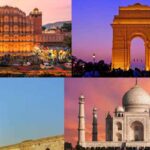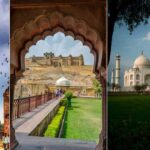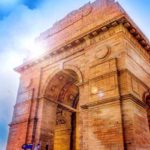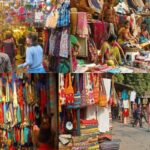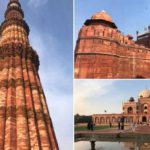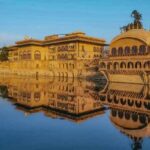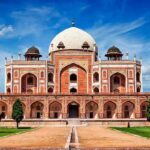Delhi Travel Information, the capital city of India, is a vibrant and captivating destination that offers a unique blend of history, culture, and modernity. With a rich historical legacy spanning several centuries, Delhi Tourism is a treasure trove for tourists seeking to explore the country’s past and experience its diverse cultural fabric. From magnificent monuments and bustling bazaars to lush gardens and mouth-watering street food, Delhi has something to offer every traveler.
One of the major attractions in Delhi is the Red Fort, a UNESCO World Heritage Site that stands as a symbol of India’s rich architectural heritage. Built during the Mughal era, this grand fortress with its imposing red sandstone walls and intricate design is a testament to the opulence and power of the Mughal emperors. Another must-visit historical site is Qutub Minar, the tallest brick minaret in the world. Dating back to the 12th century, this magnificent tower is surrounded by a complex of ancient monuments and is a testimony to Delhi’s historical significance Delhi Tour Packages.
For those interested in spirituality, a visit to Jama Masjid, one of the largest mosques in India, is highly recommended. Its stunning architecture, serene atmosphere, and panoramic views of Old Delhi make it a popular pilgrimage site. Another religious landmark is the Lotus Temple, a Bahá’í House of Worship known for its distinctive lotus-shaped structure and tranquil ambiance.
Delhi is also a paradise for shopaholics. The bustling markets of Chandni Chowk and Connaught Place offer a myriad of shopping options, from traditional handicrafts and textiles to modern fashion brands. These markets are not only great for shopping but also provide a glimpse into the local lifestyle and culinary delights. Delhi’s street food scene is legendary, with mouth-watering delicacies like chaat, kebabs, and parathas that will tantalize your taste buds Delhi Monuments.
In addition to its historical and cultural attractions, Delhi boasts several green spaces where visitors can relax and rejuvenate. The iconic Lodhi Gardens, with its beautifully landscaped lawns and historical tombs, is a perfect place for a leisurely stroll or a picnic. The serene ambiance of the Garden of Five Senses offers a peaceful retreat from the hustle and bustle of the city.
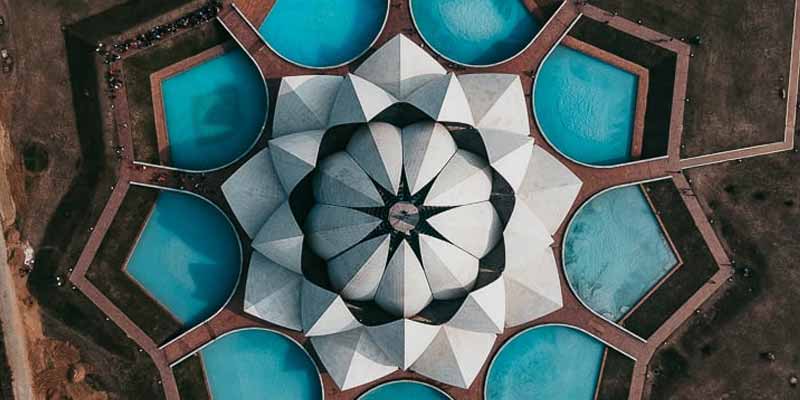
History of Delhi
Delhi, the capital city of India, has a rich and diverse history that spans over several centuries. The city has witnessed the rise and fall of numerous empires and has served as a political, cultural, and commercial center throughout its existence. From ancient settlements to medieval dynasties, British colonial rule, and the post-independence era, Delhi’s history is a tapestry of different influences and transformations.
The origins of Delhi can be traced back to ancient times, with evidence of human habitation in the area dating back to the 6th century BCE. The city has seen the rule of various empires and dynasties, each leaving its mark on its landscape and culture.
One of the earliest prominent empires in Delhi’s history was the Mauryan Empire, led by Emperor Ashoka, who controlled the region during the 3rd century BCE. The Mauryans were followed by the Kushan Empire and Gupta Empire, which brought prosperity and cultural advancements to the area.
In the 12th century CE, Delhi became the capital of the Delhi Sultanate, a Muslim kingdom established by Qutb-ud-din Aibak. The Sultanate, ruled by dynasties such as the Mamluks, Khaljis, Tughlaqs, and Sayyids, played a significant role in shaping the city’s architectural and cultural heritage. The Qutub Minar, an iconic structure in Delhi, was constructed during this period.
Delhi reached its zenith of power and influence during the reign of the Mughal Empire, which spanned from the 16th to the mid-19th century. Under Mughal emperors like Babur, Akbar, Shah Jahan, and Aurangzeb, Delhi flourished as a center of art, architecture, and trade. The majestic Red Fort and the iconic Jama Masjid were built during this time. However, Delhi faced several invasions and power struggles during the decline of the Mughal Empire, notably the invasion of Nadir Shah of Persia in 1739, which resulted in widespread destruction.
The British East India Company gained control over Delhi in the mid-19th century, following the decline of the Mughal Empire. The city became an important administrative center for British India. In 1857, Delhi became the epicenter of the Indian Rebellion against British rule, also known as the Sepoy Mutiny or the First War of Independence. The rebellion, though ultimately suppressed, marked a turning point in India’s struggle for independence.
After the rebellion, Delhi came under direct British administration and served as the capital of British India from 1911 until independence. In 1947, India gained independence from British rule, and Delhi became the capital of the newly formed country. New Delhi, a planned city designed by British architect Edwin Lutyens, was inaugurated as the capital. The city underwent rapid development and became a symbol of modern India.
Since independence, Delhi has continued to grow and evolve as a vibrant metropolis. It has witnessed significant political events, including the formation of the Republic of India in 1950 and the establishment of the Parliament House and other government buildings. Delhi has also faced challenges such as rapid urbanization, population growth, and environmental issues.
Today, Delhi is a bustling cosmopolitan city that blends ancient heritage with modern developments. It is known for its iconic landmarks, including historical sites, museums, and religious monuments. The city remains a center for political power, cultural diversity, and economic activity, reflecting its rich and diverse history.
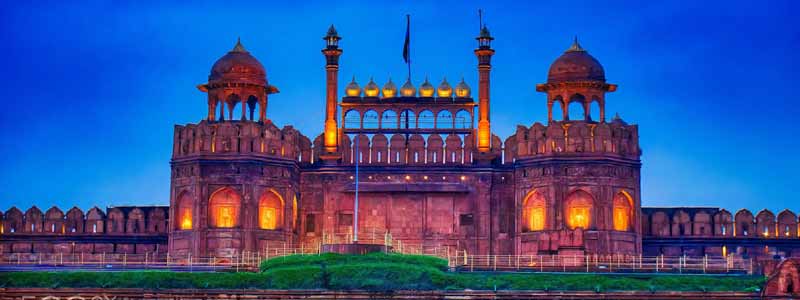
Places to Visit in Delhi
Delhi, the capital city of India, offers a plethora of attractions for visitors to explore. From historical monuments and architectural marvels to vibrant markets and cultural landmarks, here are some of the must-visit places in Delhi:
Red Fort (Lal Qila): A UNESCO World Heritage Site, the Red Fort is an iconic monument that served as the residence of Mughal emperors. Explore its impressive architecture, visit the Diwan-i-Am (Hall of Public Audience) and Diwan-i-Khas (Hall of Private Audience), and witness the grandeur of the fort.
Qutub Minar: Another UNESCO World Heritage Site, the Qutub Minar is a towering minaret built in the 12th century. Admire its intricate carvings and visit the nearby Qutub Complex, which includes other historical structures like the Iron Pillar and Alai Darwaza.
Humayun’s Tomb: Considered a precursor to the Taj Mahal, Humayun’s Tomb is a beautiful mausoleum built in the 16th century. Marvel at its Persian architecture, symmetrical gardens, and ornate details.
India Gate: A prominent landmark in Delhi, India Gate is a war memorial dedicated to Indian soldiers who lost their lives during World War I. Visit this grand structure, stroll along the Rajpath, and enjoy the surrounding lawns.
Jama Masjid: One of the largest mosques in India, Jama Masjid is a magnificent architectural masterpiece. Admire its red sandstone and marble construction, climb the minarets for panoramic views of Old Delhi, and explore the bustling lanes of the surrounding market area.
Lotus Temple: Known for its distinctive lotus flower-like shape, the Lotus Temple is a Bahá’í House of Worship. Visit this serene place, appreciate its architectural beauty, and spend time in quiet contemplation.
Akshardham Temple: This stunning temple complex showcases Indian art, culture, and spirituality. Explore its intricately carved pillars, enjoy the musical fountain show, and visit the exhibition halls that depict the life and teachings of Swaminarayan.
Chandni Chowk: Dive into the vibrant chaos of Delhi’s oldest and busiest market. Chandni Chowk is a haven for shopaholics and food enthusiasts. Explore its narrow lanes, shop for traditional textiles, jewelry, and spices, and savor delicious street food.
National Museum: Discover India’s rich history and heritage at the National Museum. It houses a vast collection of art, artifacts, and archaeological treasures, showcasing the cultural diversity of the country.
National Rail Museum: Ideal for train enthusiasts, the National Rail Museum offers a fascinating journey through India’s railway history. Explore vintage locomotives, visit the indoor gallery, and enjoy a joyride on a toy train.
These are just a few highlights, and Delhi has much more to offer. Other notable attractions include the Swaminarayan Akshardham Temple, Raj Ghat (Mahatma Gandhi’s memorial), National Zoological Park, and the bustling markets of Connaught Place and Karim’s in Old Delhi. Don’t forget to savor the diverse culinary delights that Delhi is famous for, from street food to fine dining experiences.
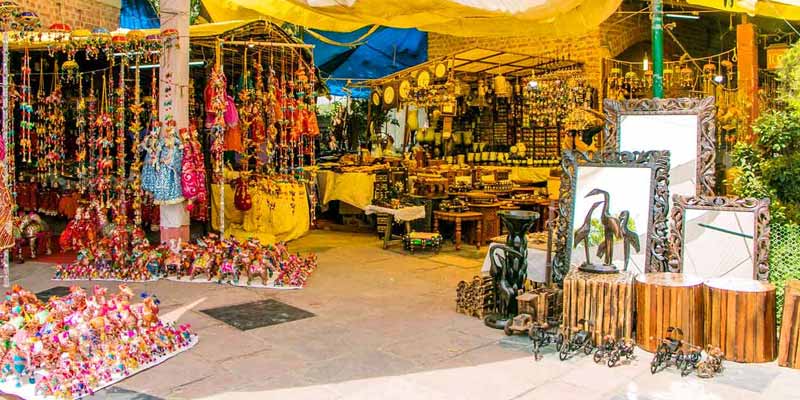
Famous Shopping Markets in Delhi
Delhi is renowned for its vibrant and diverse shopping markets, offering a wide range of products from traditional handicrafts and textiles to modern fashion, accessories, and electronics. Here are some of the famous shopping markets in Delhi:
Chandni Chowk: Located in Old Delhi, Chandni Chowk is one of the oldest and busiest markets in the city. It offers a plethora of shops selling textiles, jewelry, spices, electronic goods, and street food. Don’t miss exploring the narrow lanes of Dariba Kalan for silver jewelry and Kinari Bazaar for wedding accessories.
Connaught Place: Situated in the heart of Delhi, Connaught Place (CP) is a popular shopping and commercial hub. It is known for its circular layout, colonial architecture, and a wide range of retail stores, showrooms, restaurants, and cafes. You can find both high-end brands and budget-friendly options here.
Karol Bagh: Karol Bagh is a bustling market known for its variety of shops and street markets. It offers an extensive range of clothing, accessories, jewelry, electronics, and home decor. The Ajmal Khan Road and Ghaffar Market are famous for their affordable clothing and electronics.
Sarojini Nagar Market: Sarojini Nagar Market is a paradise for bargain hunters. Known for its trendy and affordable clothing, shoes, bags, and accessories, this market attracts locals and tourists alike. You can find both branded and unbranded items at great prices.
Lajpat Nagar: Lajpat Nagar is a bustling market known for its traditional Indian clothing, especially ethnic wear like sarees, salwar suits, and lehengas. It also offers a range of accessories, footwear, and home decor items. The Central Market in Lajpat Nagar is particularly famous.
Dilli Haat: Dilli Haat is a unique open-air craft bazaar that showcases traditional handicrafts, handlooms, and folk art from different states of India. It offers a vibrant shopping experience, along with cultural performances and a variety of regional cuisines.
Janpath Market: Located near Connaught Place, Janpath Market is a popular destination for budget shopping. It offers a wide range of clothing, accessories, home decor, and handicrafts. Bargaining is a common practice here.
Khan Market: Khan Market is a posh market known for its upscale boutiques, bookstores, cafes, and designer stores. It offers a range of fashion, accessories, home decor, and gourmet food.
These are just a few of the many shopping markets in Delhi. Each market offers a unique experience, reflecting the diverse shopping options available in the city.
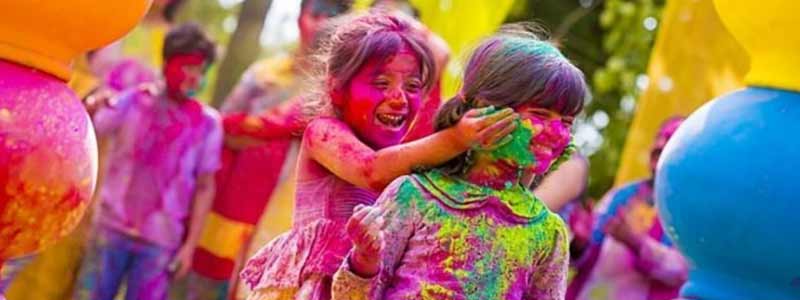
Festivals of Delhi
Delhi, the capital city of India, celebrates a plethora of festivals throughout the year, showcasing the cultural diversity and vibrancy of the region. These festivals bring people together, offering a glimpse into the rich traditions, rituals, music, dance, and cuisine. Here are some of the major festivals celebrated in Delhi:
Diwali: Diwali, also known as the Festival of Lights, is one of the most significant festivals celebrated in Delhi. It marks the victory of light over darkness and good over evil. The city is adorned with colorful lights, and people celebrate by lighting oil lamps, bursting firecrackers, exchanging sweets, and performing prayers.
Holi: Holi, the festival of colors, is celebrated with great enthusiasm in Delhi. People come together to play with vibrant colors, water balloons, and water guns. Traditional music, dance, and delicious food add to the festive spirit of Holi.
Eid: Delhi has a significant Muslim population, and the festivals of Eid-ul-Fitr and Eid-ul-Adha are celebrated with immense joy and fervor. People offer prayers at mosques, exchange greetings, wear new clothes, and share delicious meals with family and friends.
Navratri and Durga Puja: Navratri, a nine-night festival dedicated to the worship of Goddess Durga, is celebrated with great enthusiasm in Delhi. Elaborate decorations, traditional music, dance performances (Garba and Dandiya), and fasting are part of the celebrations. Similarly, Durga Puja, a festival dedicated to the worship of Goddess Durga, is celebrated by the Bengali community with grand processions, cultural programs, and elaborate pandals (temporary structures).
Christmas: The Christian community in Delhi celebrates Christmas with great joy and festivity. Churches are beautifully decorated, and people attend midnight mass. Christmas markets, carol singing, and exchanging gifts are common traditions during this festive season.
Guru Nanak Jayanti: Guru Nanak Jayanti, the birth anniversary of Guru Nanak Dev, the founder of Sikhism, is celebrated with great devotion by the Sikh community. Processions called Nagar Kirtans are taken out, and gurdwaras (Sikh temples) are beautifully decorated. People participate in prayers, sing devotional hymns, and share community meals (langar).
Republic Day: Delhi takes pride in celebrating Republic Day on 26th January each year. The day commemorates the adoption of the Indian Constitution. The highlight of the celebrations is the grand parade held at Rajpath, showcasing the cultural diversity of India, military displays, and a colorful display of floats representing different states.
Independence Day: On 15th August, Delhi joins the nation in celebrating Independence Day, marking India’s freedom from British rule. The Prime Minister hoists the national flag at the Red Fort, and cultural programs, parades, and kite flying mark the day’s celebrations.
International Mango Festival: Delhi hosts the International Mango Festival every year during the summer season. This festival celebrates the king of fruits, mango, and features a variety of mangoes, cultural performances, mango eating competitions, and culinary demonstrations.
These festivals represent just a glimpse of the vibrant cultural tapestry that Delhi offers. The city’s residents celebrate various religious, regional, and national festivals with joy, creating an atmosphere of unity and celebration.
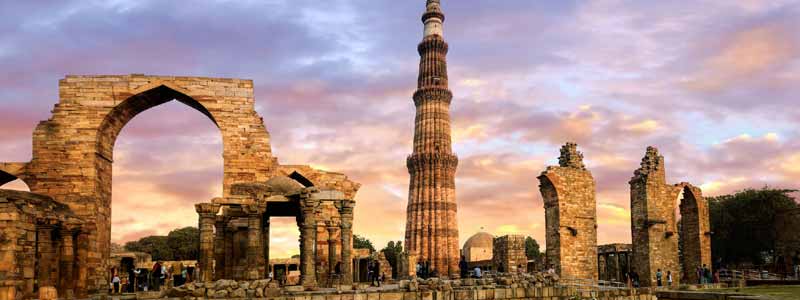
Best Time to Visit Delhi
The best time to visit Delhi depends on your preferences and the kind of experience you are seeking. Delhi experiences extreme weather conditions, with scorching summers and chilly winters. Here’s a breakdown of the seasons in Delhi:
Winter (October to February): Winter is considered the best time to visit Delhi. The weather during these months is pleasant, with average temperatures ranging from 9°C (48°F) to 20°C (68°F). It is the peak tourist season, so expect larger crowds. However, it’s also a great time to explore outdoor attractions, attend festivals, and enjoy Delhi’s street food without the discomfort of extreme temperatures.
Spring (March to April): Spring in Delhi is relatively short but enjoyable. Temperatures start to rise, ranging from 15°C (59°F) to 30°C (86°F). It’s a good time to witness the blooming flowers, visit gardens, and participate in cultural events. However, the weather can be unpredictable, with occasional dust storms and heatwaves.
Summer (May to June): Summers in Delhi are scorching hot, with temperatures soaring above 40°C (104°F). The weather is dry, and the city experiences heatwaves. It is not the most comfortable time to visit if you are sensitive to extreme heat. However, if you don’t mind the heat, you may find discounted hotel rates and fewer crowds during this season.
Monsoon (July to September): Monsoon in Delhi brings relief from the scorching heat, but it also brings heavy rainfall and humidity. The temperatures range from 25°C (77°F) to 35°C (95°F). While the rain can bring occasional inconveniences, it can also make the city look lush and vibrant. The monsoon season is a good time to explore indoor attractions, enjoy the local street food, and witness the occasional drizzle.
Considering the overall weather conditions and tourist activities, the best time to visit Delhi is typically from October to February when the weather is pleasant, and several festivals and events take place. However, if you prefer fewer crowds and are prepared for the heat, you can also consider visiting during the shoulder seasons of spring or monsoon.
How to Reach Delhi
Delhi, being the capital city of India, is well-connected and easily accessible by various modes of transportation. Here are the different ways to reach Delhi:
By Air: Delhi is served by the Indira Gandhi International Airport (IGI), which is one of the busiest airports in the country. It has both domestic and international terminals, catering to flights from major cities around the world. From the airport, you can hire a taxi, take a prepaid taxi, or use app-based ride-hailing services to reach your destination in Delhi.
By Train: Delhi is a major railway hub, and the city has several railway stations. The main railway stations are New Delhi Railway Station (NDLS), Old Delhi Railway Station (DLI), and Hazrat Nizamuddin Railway Station (NZM). These stations are well-connected to various cities across India, and trains from different parts of the country regularly arrive in Delhi. You can book train tickets through the Indian Railways website or at railway reservation counters.
By Road: Delhi has a well-developed road network and is connected to neighboring states through national highways and expressways. You can reach Delhi by private car, bus, or taxi. Several state-run and private bus services operate regular routes to and from Delhi. The Inter-State Bus Terminals (ISBT) in Delhi serve as major hubs for intercity and interstate bus services.
By Metro: Delhi has an extensive metro rail network, which is a convenient and efficient mode of transportation within the city and for reaching various parts of Delhi from nearby areas. The Delhi Metro connects major neighborhoods, commercial centers, tourist attractions, and transportation hubs. The metro is well-connected to the airport, railway stations, and bus terminals, making it a popular choice for travelers.
By Car: If you are traveling from nearby cities or regions, you can reach Delhi by car or hire a taxi. Delhi is connected to major cities through well-maintained national highways. You can either self-drive or hire a chauffeur-driven car or taxi service Delhi Travel Information.
It’s important to plan your journey in advance and consider factors such as travel time, traffic conditions, and the mode of transportation that suits your preferences and budget. Delhi’s connectivity and transportation options make it easily accessible for travelers from different parts of India and abroad.

